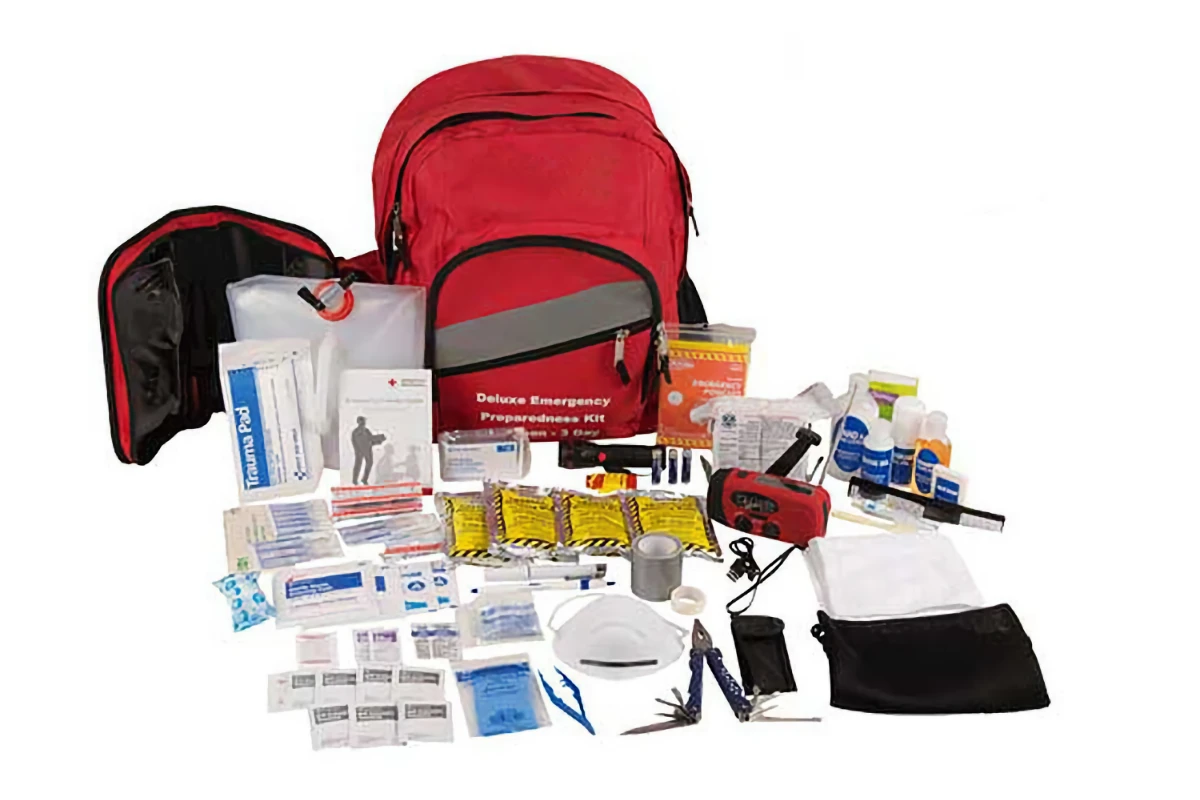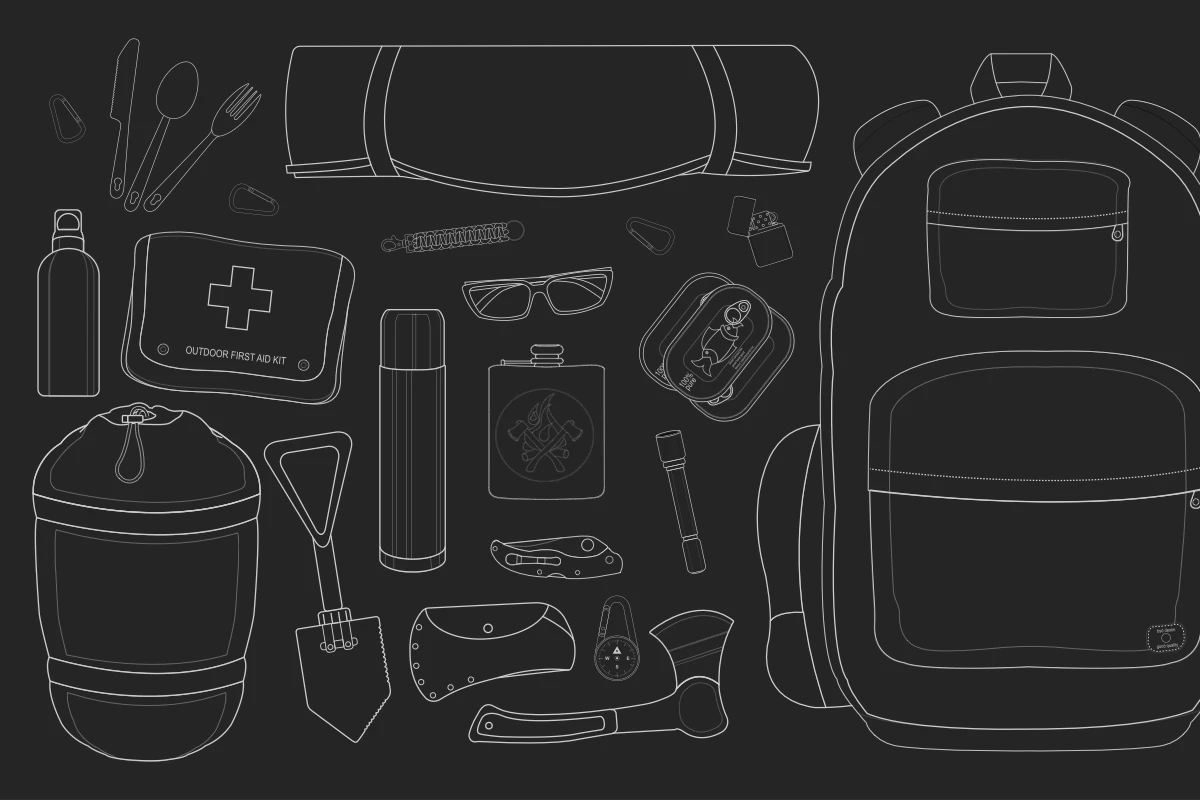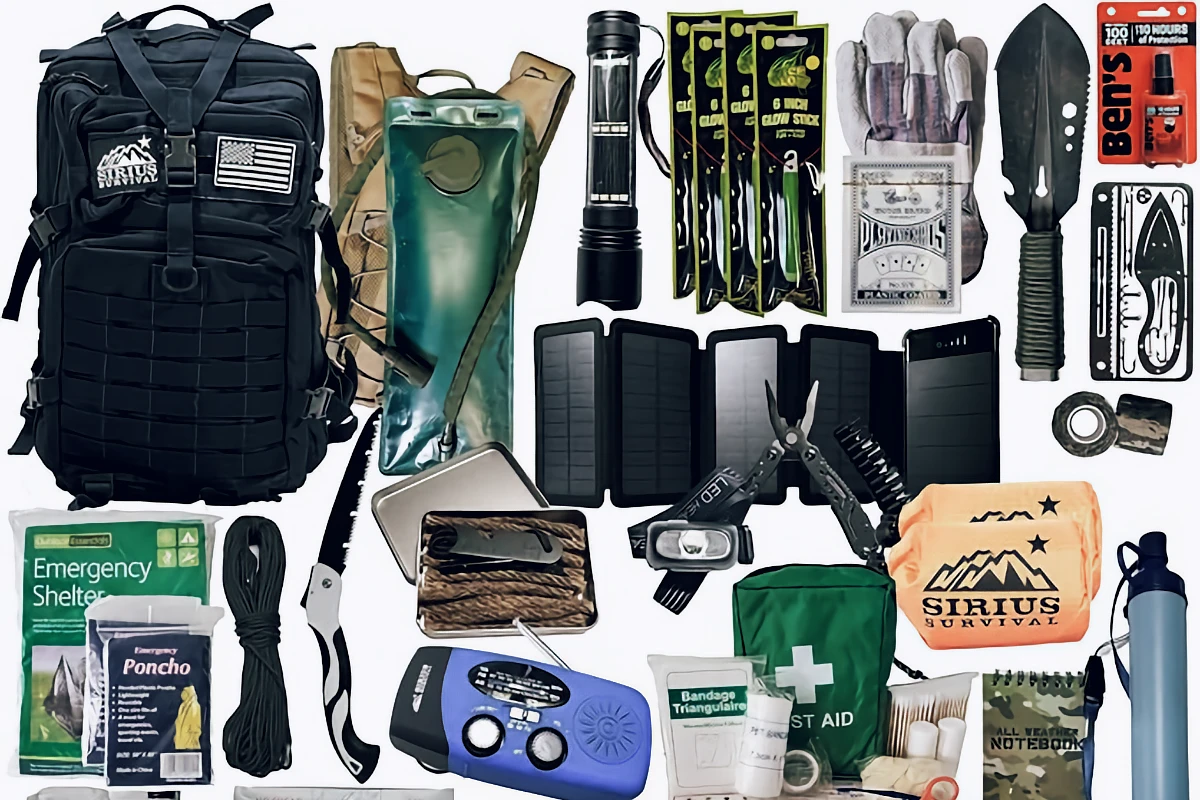Bug Out Bag Essentials: Why Every Household Needs a Bug Out Bag
When disaster strikes, you may have only minutes to evacuate your home. Whether it’s a natural disaster like a wildfire or hurricane, a man-made emergency, or a localized crisis, having a pre-packed bug out bag (BOB), or Go Bag, can make the critical difference between struggling to survive and being adequately prepared. I’ve included a printable Bug Out Bag Checklist down below to help with your bug out bag planning.
According to FEMA, less than 60% of American households have an emergency plan, and even fewer have a fully stocked emergency kit. This guide will walk you through everything you need to know about creating an effective bug out bag that could sustain you and your family for 72 hours or more in an emergency situation.

What Is a Bug Out Bag?
A bug out bag (also known as a 72-hour kit, go bag, or emergency kit) is a portable collection of supplies designed to help you survive for at least three days (72 hours) during and after an evacuation from your home. The concept originated with military “bail-out bags,” but has been adapted for civilian emergency preparedness.
The primary purpose of a bug out bag is to get you from your current location to a safer destination, whether that’s an emergency shelter, a family member’s home, or a predetermined bug out location.
The Science of Survival: Understanding Priority
When creating your bug out bag, it’s essential to understand basic survival priorities. Experts in wilderness survival and emergency management use the “Rule of 3s” to prioritize needs:
- You can survive approximately 3 minutes without air
- 3 hours without shelter in harsh environments
- 3 days without water
- 3 weeks without food
This prioritization framework should guide how you organize your bug out bag and what you prioritize in an emergency.
The Ideal Bug Out Bag: Selecting Your Pack
Choosing the Right Backpack
First off, there are plenty of prepackaged Bug Out Bags available from online retailers (Amazon affiliate link). Even Costco has similar Go Bags available from time to time. I recommend building your own as it will help you become intimately aware of what is packed and available from the outset.
That said, the foundation of your bug out bag is the backpack itself. This isn’t just a container—it’s the system that will allow you to carry everything you need while maintaining mobility.
Key features to look for:
- Capacity: 40-65 liters is ideal for most adults (adjust according to your body size and strength)
- Durability: Water-resistant materials with reinforced stitching at stress points
- Comfort: Padded shoulder straps, hip belt, and back panel
- Compartmentalization: Multiple compartments for organized access
- Weight distribution: Design that keeps weight close to your back and centered
- Low profile appearance: Avoid tactical-looking packs that draw attention in some scenarios
Recommended backpacks:
- 5.11 Tactical RUSH72 – Military-grade durability with excellent organization
- Osprey Atmos AG 65 – Outstanding comfort for longer treks
- The North Face Terra 55 – Balanced everyday appearance with technical features
- Mystery Ranch Urban Assault – Urban-friendly design with rugged construction
Remember that the perfect backpack depends on your body type, strength, and specific needs.

Essential Categories: Building Your 72-Hour Kit
1. Water & Hydration (Top Priority)
Without water, your survival timeline is measured in days, not weeks. Your bug out bag should include both water and the means to purify more.
What to pack:
- Portable water containers: 2-3 liters minimum (stainless steel bottles can also be used for boiling)
- Water filtration system: Portable filter like the Sawyer Mini or LifeStraw (can filter up to 100,000 gallons)
- Water purification tablets: Chlorine dioxide tablets as backup (effective against bacteria, viruses, and some parasites)
- Collapsible water container: 2-liter minimum for collecting additional water
- Electrolyte packets: To prevent dehydration and maintain vital minerals
Weight consideration: Water is heavy (1 liter = 2.2 pounds). Consider balancing carried water with purification capability.
2. Emergency Shelter & Warmth
Exposure to extreme elements can affect your survival timeline drastically. Your shelter system should protect you from rain, wind, and temperature extremes.
What to pack:
- Emergency shelter: Lightweight tent, bivy sack, or at minimum an emergency tube tent
- Sleeping bag: Compact, rated for the lowest temperatures in your region
- Sleeping pad: Provides insulation from the ground (critical for preventing hypothermia)
- Emergency blanket: Mylar/space blanket reflects up to 90% of body heat
- Tarp: Multi-purpose item for shelter, ground cover, water collection
- Paracord: 50-100 feet of 550 paracord for shelter construction
- Fire starting tools: Waterproof matches, ferrocerium rod, lighters (multiple options)
- Tinder: Commercial fire starters or homemade waxed cotton balls
Seasonal considerations: Adjust your shelter and insulation based on your local climate and seasons.
3. First Aid & Medications
Medical emergencies don’t wait for convenient times. A comprehensive first aid kit can address wounds, illness, and chronic conditions.
What to pack:
- Personal medications: 7-day supply of essential prescriptions
- Comprehensive first aid kit including:
- Bandages (various sizes)
- Gauze pads and rolls
- Medical tape
- Antiseptic wipes
- Triple antibiotic ointment
- Pain relievers (acetaminophen, ibuprofen)
- Anti-diarrheal medication
- Antihistamines
- Trauma supplies (tourniquet, hemostatic gauze)
- Tweezers, scissors, and safety pins
- Medical gloves
- CPR face shield
- Emergency dental kit
- Extra eyeglasses or contacts if needed
Consider adding:
- QuikClot or other hemostatic agent for severe bleeding
- Emergency trauma shears
- Splint materials
- Basic first aid manual
4. Food & Nutrition
While you can survive weeks without food, maintaining energy and cognitive function requires regular caloric intake.
What to pack:
- High-calorie, ready-to-eat foods: 2,000-3,000 calories per person per day
- Energy bars
- Freeze-dried meals
- Jerky and dried meats
- Nuts and trail mix
- Peanut butter packets
- Compact cooking system: Small stove and fuel
- Metal container: For boiling water and cooking
- Utensils: Spork or compact utensil set
- Can opener if including canned foods
- Food storage bags
Food selection criteria:
- High calorie-to-weight ratio
- Long shelf life (check and rotate regularly)
- Minimal preparation required
- Foods that don’t increase thirst
5. Tools & Equipment
The right tools expand your capabilities in an emergency and can help with shelter construction, food procurement, and navigation.
What to pack:
- Multi-tool with pliers, knife, screwdrivers
- Fixed-blade knife (4-6 inch blade)
- Folding saw or compact hatchet
- Headlamp and flashlight with extra batteries
- Emergency radio (hand-crank and/or solar powered)
- Maps of your region (paper, not digital)
- Compass
- Whistle for signaling
- Duct tape (wrapped around a water bottle or pencil to save space)
- Work gloves
- Pen and waterproof paper
- Cash in small denominations and coins for vending machines
- Extra phone charger and portable battery pack
6. Clothing & Personal Items
Appropriate clothing can be your first line of defense against the elements. Pack versatile items that layer well.
What to pack:
- Change of clothes appropriate for your climate
- Extra socks (3 pairs minimum)
- Durable, comfortable footwear
- Rain gear
- Hat (sun protection in summer, warmth retention in winter)
- Bandana or shemagh (multiple uses)
- Hygiene kit:
- Toothbrush and toothpaste
- Biodegradable soap
- Hand sanitizer
- Toilet paper
- Menstrual supplies
- Wet wipes
- Travel towel
- Sunglasses
- Sunscreen
- Insect repellent
7. Important Documents & Communication
In the aftermath of a disaster, documentation and communication capability can be crucial for receiving aid or proving identity.
What to pack:
- Waterproof document container with:
- Copies of identification (driver’s license, passport)
- Insurance policies
- Property deeds/leases
- Birth certificates
- Medical information (immunizations, conditions, medications)
- Emergency contact information
- Photos of family members (for reunion purposes)
- Local maps with evacuation routes marked
- Emergency contact list (laminated)
- Pre-paid phone card
- Whistle and signal mirror
- Notepad and pencil
Digital alternatives: Consider a password-protected USB drive with encrypted copies of important documents.
8. Self-Defense (Optional)
Personal protection needs vary widely based on individual circumstances, local laws, and personal expertise. Only include what you’re trained to use and what’s legal in your area.
Options to consider:
- Pepper spray or other legal defensive spray
- Personal alarm
- Tactical flashlight with strobe function
- Self-defense tools you’re trained to use
Important note: If including any defensive tools, ensure you have proper training and understand local laws regarding their possession and use.
Special Considerations for Different Scenarios
Family Bug Out Bags
When preparing bug out bags for a family, consider these additional factors:
- Weight distribution based on each person’s carrying capacity
- Children’s needs: Comfort items, familiar snacks, entertainment
- Pet supplies if evacuating with animals
- Communication plan and meeting points if separated
- Role-specific gear distributed among family members
Urban vs. Rural Evacuation
Your location and likely evacuation scenarios should influence your bug out bag contents:
Urban considerations:
- Maps of public transportation and evacuation routes
- Dust masks for air quality issues
- Compact shelter options for dense environments
- Cash for purchasing supplies or transportation
Rural considerations:
- More extensive navigation tools
- Hunting/fishing supplies if appropriate
- More robust shelter components
- Additional water purification capacity
Climate-Specific Adaptations
Tailor your bug out bag to your region’s climate conditions:
Hot climates:
- More water capacity
- Sun protection (hat, sunscreen, lightweight long-sleeved clothing)
- Electrolyte replacement
- Insect protection
Cold climates:
- Extra insulation layers
- Chemical hand warmers
- More robust fire-starting capabilities
- Higher-calorie food options
- Insulated water containers to prevent freezing
Maintaining Your Bug Out Bag
A bug out bag is not a “set it and forget it” preparation. Regular maintenance ensures it remains effective when needed.
Maintenance schedule:
- Monthly check: Quick inventory verification
- Quarterly review: Thorough inspection, replace any expired items
- Seasonal update: Adjust contents based on changing weather
- Annual overhaul: Complete disassembly, evaluation, and repacking
Test your gear: Practice using your equipment before you need it in an emergency. Know how to set up your shelter, use your water filter, and operate all tools.

Bug Out Bag Checklist: Printable Version
Below is a condensed checklist you can print and use when assembling or checking your bug out bag:
Water & Hydration
- [ ] Water bottles (2-3 liters)
- [ ] Water filter/purifier
- [ ] Water purification tablets
- [ ] Collapsible water container
- [ ] Electrolyte packets
Shelter & Warmth
- [ ] Emergency shelter/tent
- [ ] Sleeping bag
- [ ] Sleeping pad
- [ ] Emergency blanket
- [ ] Tarp
- [ ] Paracord (50-100 ft)
- [ ] Fire starting tools (multiple methods)
- [ ] Tinder
First Aid & Medications
- [ ] Personal medications (7-day supply)
- [ ] First aid kit
- [ ] Emergency dental kit
- [ ] Extra eyeglasses/contacts
Food & Nutrition
- [ ] High-calorie foods (2,000-3,000 calories/person/day)
- [ ] Compact stove and fuel
- [ ] Metal container for cooking
- [ ] Utensils
- [ ] Can opener
- [ ] Food storage bags
Tools & Equipment
- [ ] Multi-tool
- [ ] Fixed-blade knife
- [ ] Folding saw or hatchet
- [ ] Headlamp and flashlight
- [ ] Extra batteries
- [ ] Emergency radio
- [ ] Maps
- [ ] Compass
- [ ] Whistle
- [ ] Duct tape
- [ ] Work gloves
- [ ] Writing materials
- [ ] Cash
- [ ] Phone charger/battery pack
Clothing & Personal Items
- [ ] Change of clothes
- [ ] Extra socks
- [ ] Sturdy footwear
- [ ] Rain gear
- [ ] Hat
- [ ] Bandana/shemagh
- [ ] Hygiene kit
- [ ] Sunglasses
- [ ] Sunscreen
- [ ] Insect repellent
Documents & Communication
- [ ] Waterproof document container with essential paperwork
- [ ] Emergency contact list
- [ ] Pre-paid phone card
- [ ] Signaling devices
Self-Defense (Optional)
- [ ] Legal defensive options appropriate to your situation and training
Beyond the Bag
A bug out bag is a crucial component of emergency preparedness, but it’s only one part of a comprehensive plan. Remember these additional considerations:
- Know when to bug out: Develop clear criteria for when evacuation is necessary versus when sheltering in place is safer.
- Have a destination: Identify multiple potential locations where you could go in different types of emergencies.
- Plan your routes: Map primary and alternate evacuation routes from your home to your bug out locations.
- Practice: Conduct occasional drills with your family to ensure everyone knows what to do.
- Stay informed: Maintain awareness of potential threats in your area and have reliable information sources.
Building an effective bug out bag is an investment in your safety and peace of mind. While we hope you never need to use it, having these preparations in place can transform a crisis from a potential catastrophe into a manageable emergency.
Disclaimer: This guide provides general information on emergency preparedness. Individual needs may vary based on personal circumstances, regional considerations, and specific emergency scenarios. Regularly review official guidance from FEMA, the Red Cross, and your local emergency management agencies.